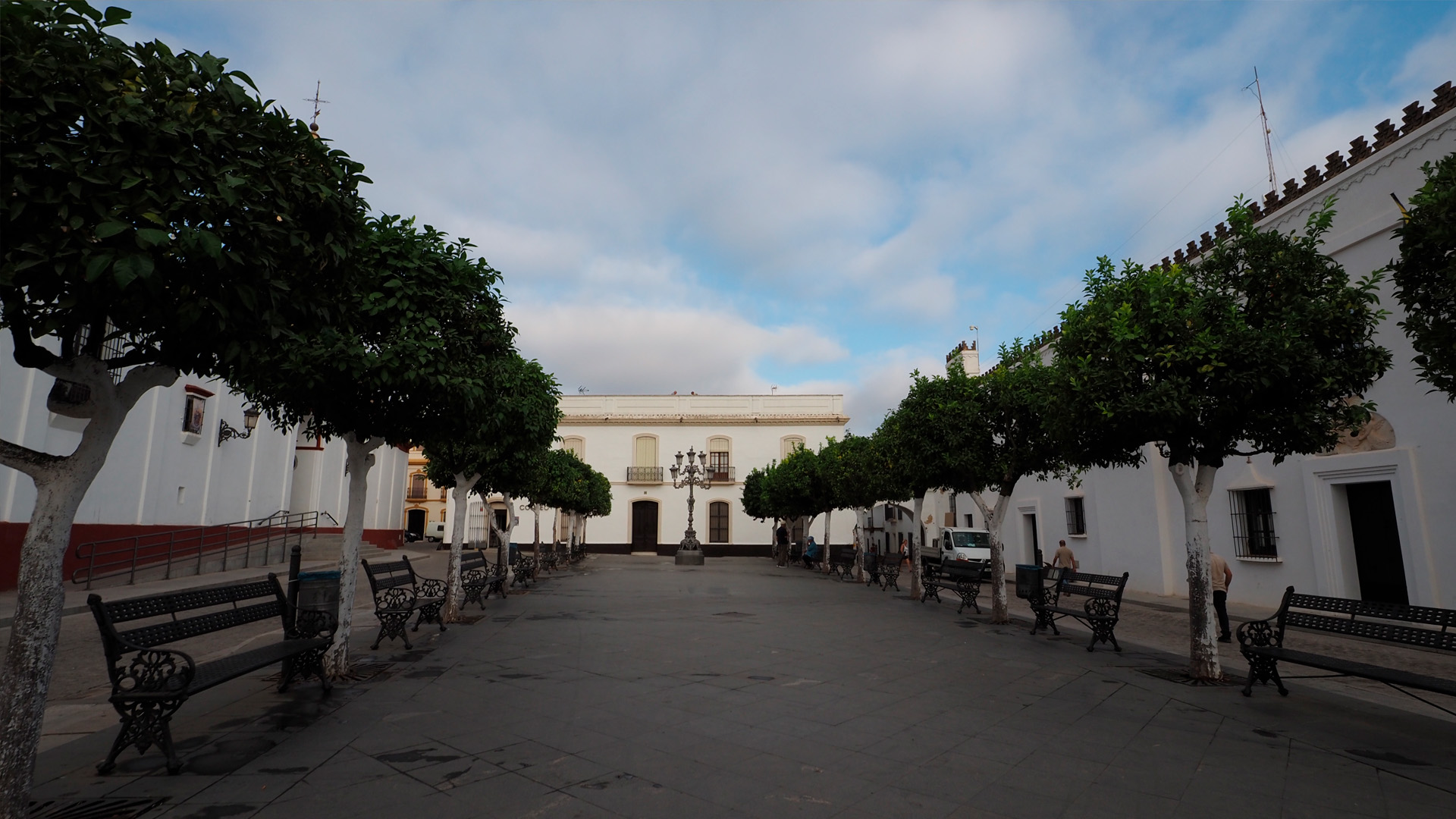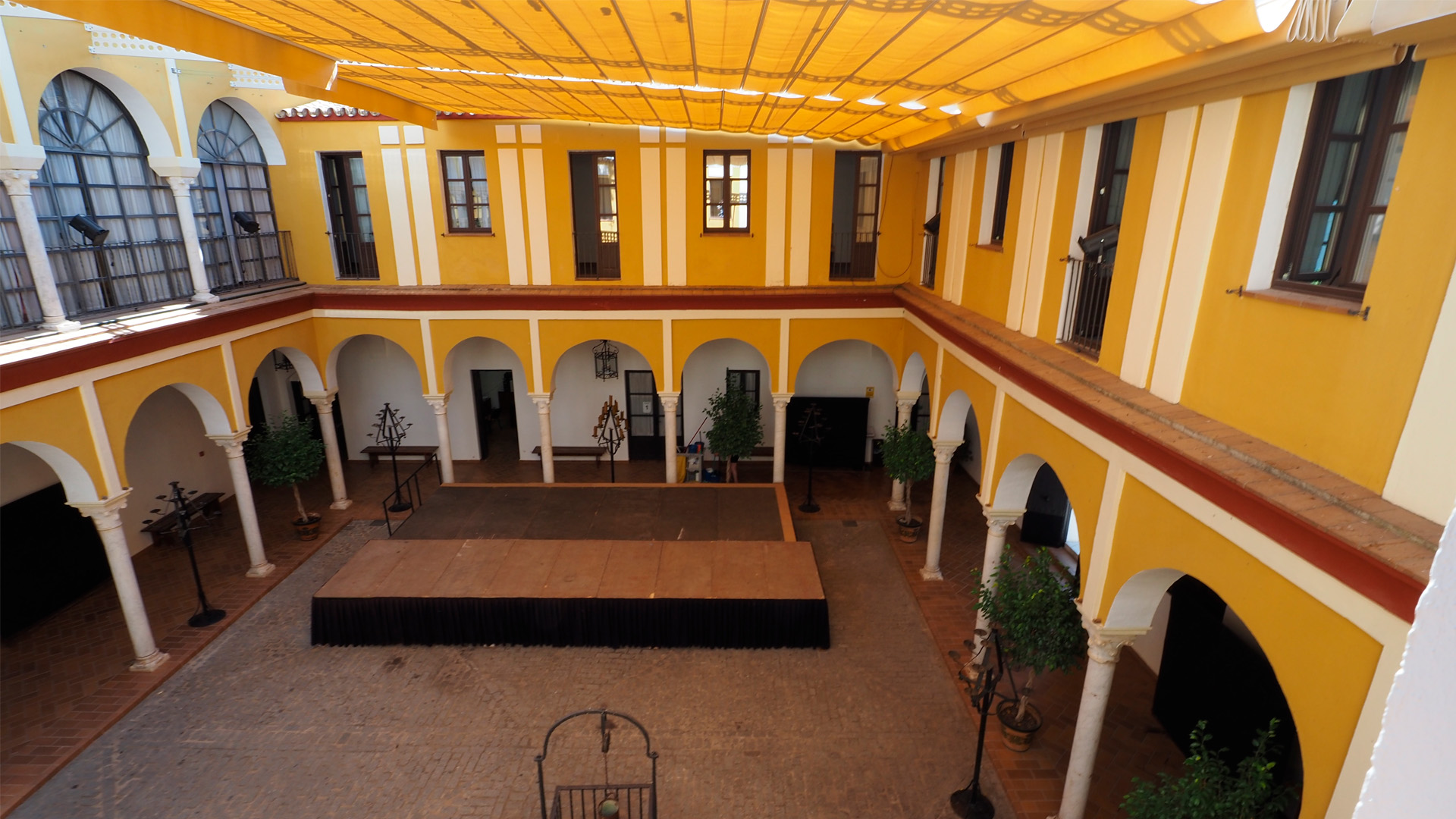Abbiamo preparato 3 tour virtuali in vista della vostra visita.
Ora potete visitare i monumenti emblematici di Olivares dal vostro smartphone o PC. Cliccate sul pulsante qui sotto per iniziare la vostra visita, ci vediamo dentro!
Guardate come appaiono i suoi 3 riferimenti monumentali in 3D

La Plaza de España, che attualmente è il centro nevralgico della città, un tempo era la piazza d’armi del palazzo della contea. È delimitato dagli edifici della Collegiata, dal Palazzo e dal Granaio o Alfolí, un edificio per l’immagazzinamento del grano eretto tra il XVII e il XVIII secolo, che conserva sulla facciata elementi stilistici dello stile barocco.
Le origini della città di Olivares risalgono all’epoca romana, quando, dopo la conquista di Baetica da parte di un soldato romano di nome Turculus, il terreno oggi occupato dalla città fu trasformato nel tempo in un insediamento noto come Estercolines o Estercolinas.
Costruito nella seconda metà del XVI secolo da Don Pedro de Guzmán, 1° Conte di Olivares, fu arricchito nel XVII secolo da Don Gaspar de Guzmán y Pimentel, Conte Duca di Olivares. Residenza dei conti di Olivares, in seguito sarebbe stata anche la residenza degli abati e dei canonici della Collegiata. Di stile rinascimentale e composizione simmetrica, è affiancato da due archi a sesto acuto coronati da merli con decorazioni a bassorilievo. Il portale principale presenta sottili semicolonne in marmo genovese su uno stipite, mentre il portale centrale presenta lo stemma della Casa de los Guzmanes, in marmo genovese, che rappresenta due arpie che reggono lo stemma, sormontate da un drago alato. Attualmente sede del Municipio, offre una mostra permanente di riproduzioni artigianali di costumi d’epoca barocca.


Il secondo conte di Olivares, Enrique de Guzmán y Ribera, fu responsabile della fondazione della Cappella di Olivares. Tra il 1582 e il 1591, don Enrique ricoprì uno degli incarichi più importanti del suo tempo, l’ambasciata spagnola a Roma; trattò con tre pontefici, Gregorio XIII, Sisto V e Gregorio XIV, il primo dei quali approvò la fondazione della Cappella di Olivares e il secondo gli concesse importanti bolle che accordavano alla Cappella notevoli privilegi.
Il terzo conte di Olivares, Gaspar de Guzmán y Pimentel, passato alla storia della Spagna per essere stato il favorito del re Filippo IV nell’ereditare il casato di Olivares, manifestò l’intenzione di elevare lo status della cappella fondata dal padre, proponendo così l’erezione della chiesa a collegiata, grazia che infine ottenne da papa Urbanc Vill con bolla del 1° marzo 1623, anche se queste bolle non arrivarono in Spagna fino al 1625.

Ruta Conde Duque Olivares 2022. Todos los derechos reservados © Nattule. Desarrollo web NattuAR.
We firmly believe that the internet should be available and accessible to anyone, and are committed to providing a website that is accessible to the widest possible audience, regardless of circumstance and ability.
To fulfill this, we aim to adhere as strictly as possible to the World Wide Web Consortium’s (W3C) Web Content Accessibility Guidelines 2.1 (WCAG 2.1) at the AA level. These guidelines explain how to make web content accessible to people with a wide array of disabilities. Complying with those guidelines helps us ensure that the website is accessible to all people: blind people, people with motor impairments, visual impairment, cognitive disabilities, and more.
This website utilizes various technologies that are meant to make it as accessible as possible at all times. We utilize an accessibility interface that allows persons with specific disabilities to adjust the website’s UI (user interface) and design it to their personal needs.
Additionally, the website utilizes an AI-based application that runs in the background and optimizes its accessibility level constantly. This application remediates the website’s HTML, adapts Its functionality and behavior for screen-readers used by the blind users, and for keyboard functions used by individuals with motor impairments.
If you’ve found a malfunction or have ideas for improvement, we’ll be happy to hear from you. You can reach out to the website’s operators by using the following email
Our website implements the ARIA attributes (Accessible Rich Internet Applications) technique, alongside various different behavioral changes, to ensure blind users visiting with screen-readers are able to read, comprehend, and enjoy the website’s functions. As soon as a user with a screen-reader enters your site, they immediately receive a prompt to enter the Screen-Reader Profile so they can browse and operate your site effectively. Here’s how our website covers some of the most important screen-reader requirements, alongside console screenshots of code examples:
Screen-reader optimization: we run a background process that learns the website’s components from top to bottom, to ensure ongoing compliance even when updating the website. In this process, we provide screen-readers with meaningful data using the ARIA set of attributes. For example, we provide accurate form labels; descriptions for actionable icons (social media icons, search icons, cart icons, etc.); validation guidance for form inputs; element roles such as buttons, menus, modal dialogues (popups), and others. Additionally, the background process scans all of the website’s images and provides an accurate and meaningful image-object-recognition-based description as an ALT (alternate text) tag for images that are not described. It will also extract texts that are embedded within the image, using an OCR (optical character recognition) technology. To turn on screen-reader adjustments at any time, users need only to press the Alt+1 keyboard combination. Screen-reader users also get automatic announcements to turn the Screen-reader mode on as soon as they enter the website.
These adjustments are compatible with all popular screen readers, including JAWS and NVDA.
Keyboard navigation optimization: The background process also adjusts the website’s HTML, and adds various behaviors using JavaScript code to make the website operable by the keyboard. This includes the ability to navigate the website using the Tab and Shift+Tab keys, operate dropdowns with the arrow keys, close them with Esc, trigger buttons and links using the Enter key, navigate between radio and checkbox elements using the arrow keys, and fill them in with the Spacebar or Enter key.Additionally, keyboard users will find quick-navigation and content-skip menus, available at any time by clicking Alt+1, or as the first elements of the site while navigating with the keyboard. The background process also handles triggered popups by moving the keyboard focus towards them as soon as they appear, and not allow the focus drift outside of it.
Users can also use shortcuts such as “M” (menus), “H” (headings), “F” (forms), “B” (buttons), and “G” (graphics) to jump to specific elements.
We aim to support the widest array of browsers and assistive technologies as possible, so our users can choose the best fitting tools for them, with as few limitations as possible. Therefore, we have worked very hard to be able to support all major systems that comprise over 95% of the user market share including Google Chrome, Mozilla Firefox, Apple Safari, Opera and Microsoft Edge, JAWS and NVDA (screen readers), both for Windows and for MAC users.
Despite our very best efforts to allow anybody to adjust the website to their needs, there may still be pages or sections that are not fully accessible, are in the process of becoming accessible, or are lacking an adequate technological solution to make them accessible. Still, we are continually improving our accessibility, adding, updating and improving its options and features, and developing and adopting new technologies. All this is meant to reach the optimal level of accessibility, following technological advancements. For any assistance, please reach out to